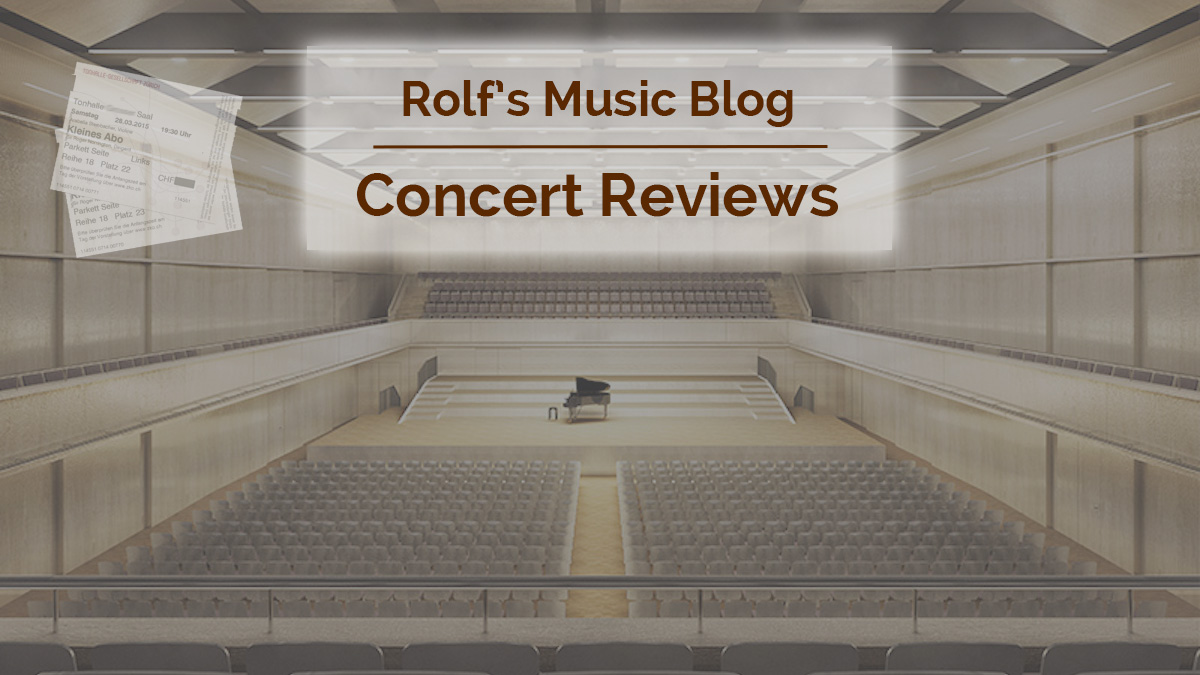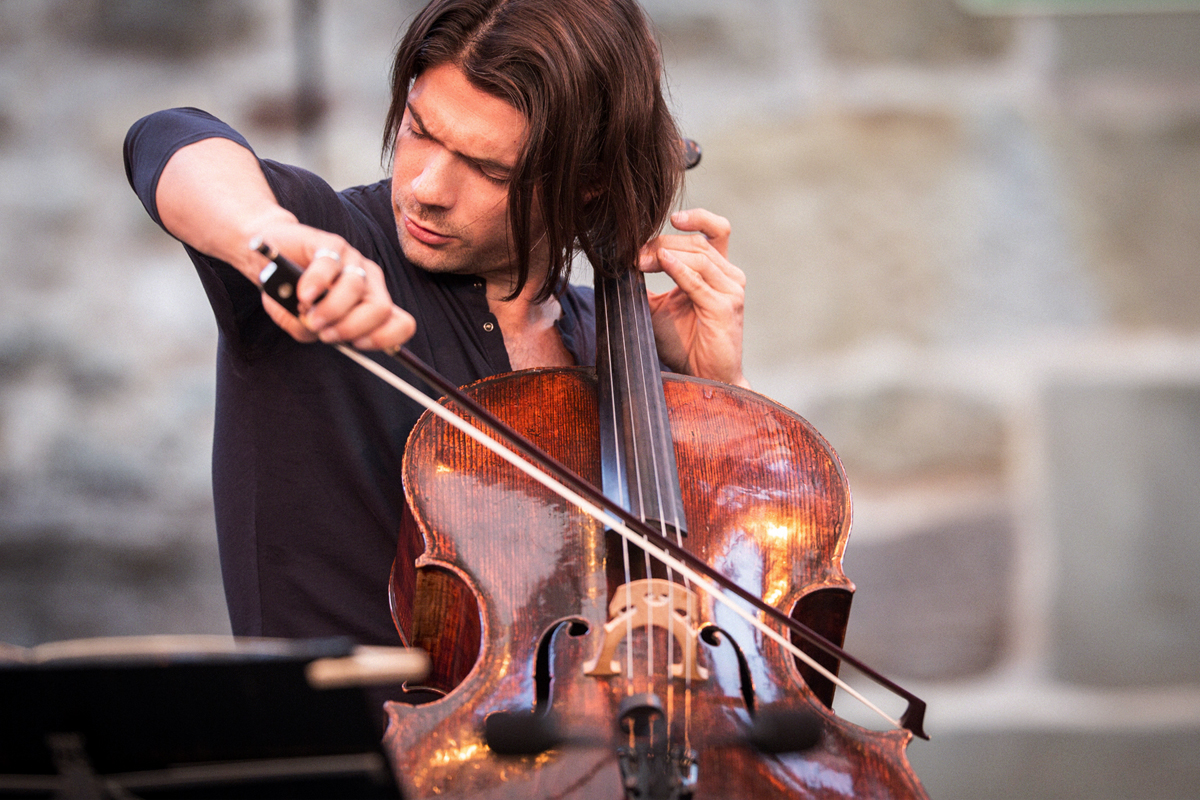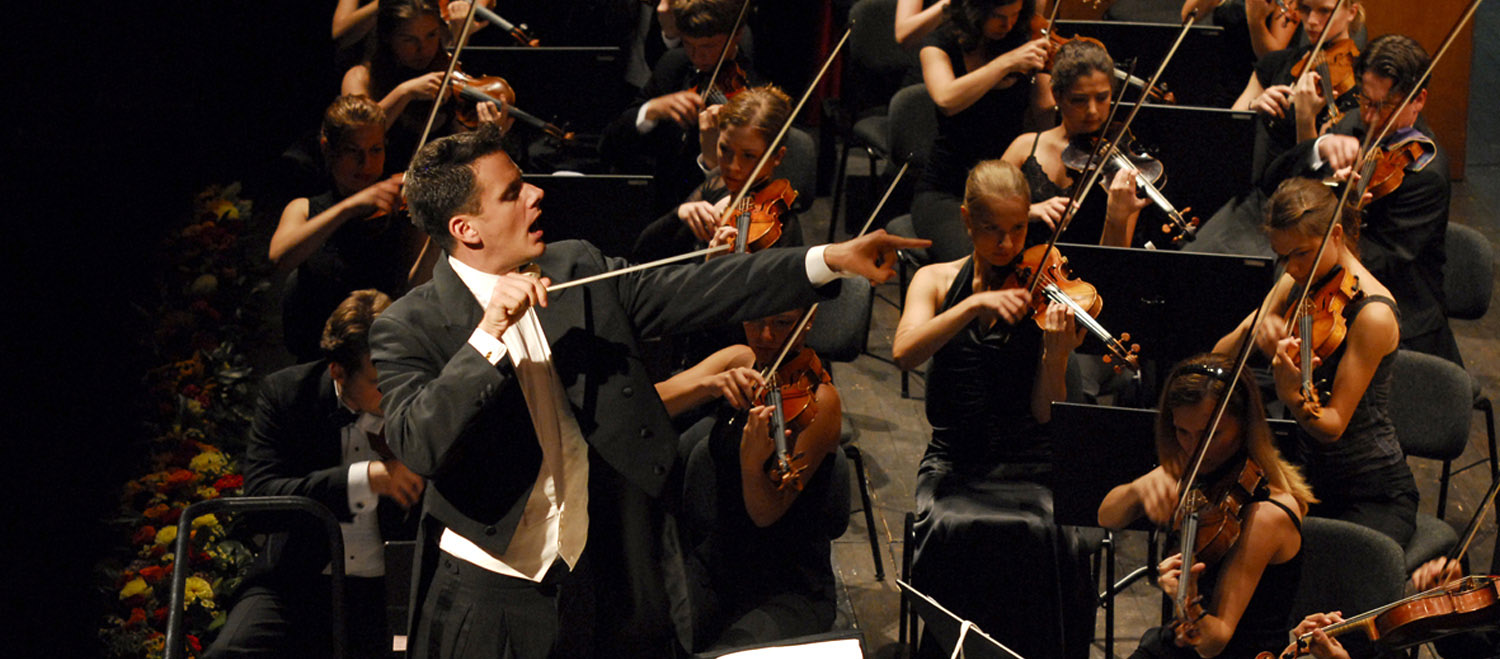Gautier Capuçon, Philippe Jordan / Vienna Symphony Orchestra
Strauss: Don Quixote & Ein Heldenleben
Tonhalle Maag, Zurich, 2018-06-09

2018-06-21 — Original posting
Richard Strauss, nachgedoppelt: Gautier Capuçon, Philippe Jordan und die Wiener Symphoniker in Zürich — Zusammenfassung
Eine Sternstunde, ausschließlich mit Richard Strauss! Philippe Jordan und die Wiener Symphoniker präsentierten die Tondichtungen “Ein Heldenleben” und “Don Quixote” in hinreißenden Interpretationen. In letzterer erlebte man Gautier Capuçon als intensiv-subtilen Solisten.
Table of Contents
Introduction
In this concert, Philippe Jordan (*1974, see also Wikipedia) was conducting the Vienna Symphony Orchestra (VSO, Wiener Symphoniker). Philippe Jordan grew up in Zurich. Now, at the age of 43, he seems to be near the culmination of a stellar career. I have previously reviewed a concert (Zurich, 2015-09-04) with Philippe Jordan conducting this orchestra. For further information on orchestra and conductor see that earlier post. The one thing to add here is that in the meantime, Philippe Jordan has been appointed music director of the Vienna State Opera, starting with the 2020/2021 season.
Also in the case of the cellist Gautier Capuçon (*1981, see also Wikipedia), this is not my first encounter: I have witnessed him playing in a concert in Zurich, on 2015-09-16, and a few months later again in Lucerne, on 2016-01-13. Gautier Capuçon played a 1701 cello by Matteo Goffiller (1659 – 1742).
Programming
Already well ahead of the concert, when studying the concert programs, I realized that there would be two concerts featuring Richard Strauss within three days. Not only that, but both concerts (one on Thursday, this one on Saturday, both in the same venue) included Strauss’ “Don Quixote“. The first one was with the Tonhalle Orchestra, conducted by Lionel Bringuier, the second one—reviewed here—combined that tone poem with its sister composition, “Ein Heldenleben” (A Hero’s Life), by the same composer.
Does such short-term repetition in concert programming make sense? It does seem questionable. However, the organizer for the first concert was the Tonhalle-Gesellschaft. That concert on thursday was largely attended by subscription audience which was bidding farewell to the Chief Conductor of the Tonhalle Orchestra Zurich, Lionel Bringuier. This organizer for this second concert was the Foundation Migros Kulturprozent which is serving an entirely different audience. Their goal is to make concerts available to people / circles that otherwise rarely attend classical concert. So, the number of people who attended both these concerts presumably was very small.
A Chance for Comparison?
On the other hand, for those not afraid of exposing themselves to an overdose of Richard Strauss: wasn’t this an ideal and unique opportunity to compare two performances? First to hear “Don Quixote” first with the favorite local orchestra and its chief conductor. Then, two days later, one could listen to the very same work in the same venue, the same acoustics, but with different artists!
Indeed, the experiment was worth it, as it wasn’t just about listening to two different interpretations, but at the same time, one could compare two vastly different orchestral cultures. That said, the comparison turned out to be unfair, as the now departing chief conductor of the Tonhalle Orchestra clearly does not play in nearly the same league as Philippe Jordan. That means that in the previous concert, the Tonhalle Orchestra Zurich didn’t nearly show its full potential. I’ll therefore refrain from qualitative comparisons. On the other hand, it is well worth looking at differences in sound (sound culture) and in how the two sets of artists approach the interpretation of Strauss’ tone poem.
Differences in the Setup
Both orchestras showed up in the required, large formation. However, there were differences in the arrangement on the podium. The Tonhalle Orchestra had used the “modern” setup (both violins on the left, followed by violas, cellos on the right). The Vienna Symphony Orchestra used an “antiphonal” setup, with the two violin voices at either side of the podium, violas on the rear left, cellos on the rear right, and the double basses in the far right, behind the second violins. These changes don’t explain the huge differences in the orchestral soundscape, though—see below.
Concert & Review
Strauss: Tone Poem “Don Quixote“, op.35
Richard Strauss (1864 – 1949) wrote his Tone Poem “Don Quixote“, op.35, a set of “Fantastic Variations on a Theme of Knightly Character”, in Munich, in 1897. The score is for cello, viola and orchestra. It is based on the famous novel “Don Quixote de la Mancha” by Miguel de Cervantes (1547 – 1616). I have written about concert performances of this music before: once in the KKL Lucerne, on 2017-08-17, and then, a very recent instance, just two days ago, in this same location: Tonhalle Maag, Zurich, 2018-06-07. I therefore refrain from descriptive text (structure of the Symphonic Poem, etc.)—rather, see one of these earlier posts for information.
The Performance
Revisiting Acoustics
I have often written about the dry, analytic acoustics in the Tonhalle Maag. The concert on 2018-06-07 was just another example of an orchestra overloading the acoustics. I suspect that it’s partly the insufficient ceiling height that causes a limitation in the amount of volume which the hall supports. The other characteristic quality of the venue is in the acoustics being very dry, analytic. This is not necessarily a bad attribute, as it helps the transparency of orchestral performances, as well as the spatial clarity. With this, it favors Spaltklang, i.e., wind and string instruments (if not also woodwind and brass sections) appearing as separate (acoustic) entities. These are findings from performances with the “local” Tonhalle Orchestra.
To my amazement, the performance with Philippe Jordan and the Vienna Symphonics seemed to contradict most of my perceptions about the dry, analytical, and limited-capacity acoustics in this venue. True, there is little, if any reverberation (apart from electronically generated spatiality). However, the Spaltklang obviously is not an inherent property of the venue. Rather, it also depends on the articulation, the sound culture, the internal, dynamic balance, etc. of an orchestra.
Orchestral Sound
To a certain degree, the remarkably soft, silky tone of the high strings seemed the predominant sound in the orchestral soundscape, even though it did not oppress the other voices. The wind instruments didn’t so much appear as a group of their own, but rather added color by mixing with the other voices. Yet, they retained sufficient weight and clarity to maintain transparency among themselves.
Philippe Jordan’s control of the acoustic balance seemed remarkable. Furthermore, he not only carefully shaped the dynamics, but he also appeared to have diligently adjusted the overall dynamics / volume to the acoustic capacity of the venue. Nothing, even in the fff, sounded noisy or otherwise too loud. In addition, it seemed almost a miracle how he managed to give the soloists the space to retain their presence down to the finest ppp and below. They rarely ever (if at all) had problems with drowning in the sound of the orchestra. And Philippe Jordan seemed to indulge in the colors that his ensemble produced.
Overall, compared to the performance of the Tonhalle Orchestra, the sound was not quite as clear and transparent, nor was it ever dry or academic. The articulation was gradually broader, more mellow. On top of that, the performance seemed a tad calmer, but with more freedom, more richness in agogics. No rushing, no pushing, but rich, natural tempo fluctuations throughout a phrase. And the wind soloists (clarinet, oboe) could live out their phrasing—every phrase seemed to have a life of its own.
Solo Cello / Don Quixote
Compared to the previous concert, not just the orchestra sounded vastly different, but also the soloists seemed to differ in their approach to the composition from the soloists in the previous concert. I didn’t see much, if any caricature, nor any exaggeration in the playing, the mimics, the gestures of the soloists. Humor, irony (as present in the composition, or in Cervantes’ novel) worked through the music. Gautier Capuçon lived in the music, often played freely, by heart, keeping intense eye contact with conductor and orchestra. He seemed to listen carefully at all times.
With his intense, expressive, yet extremely subtle playing—and of course the beautiful, finely singing tone of his precious Goffriller cello—he touched the innermost of the listeners’ hearts. Despite all the expression, Capuçon’s playing was unpretentious, he didn’t try catching extra attention through gestures or mimics—and yet, as soon as he started playing, everybody’s attention seemed to focus on him. This also holds true for the more recitative-like segments, which were narrating, telling stories without extra mimics etc.
Capuçon’s playing was flawless throughout—with the minor exception of one missed tone, which he apparently didn’t want to correct (or could not rectify in a sensible way).
Solo Viola, Solo Violin
I was very pleased with the sonority of the solo viola (Herbert Müller), which complemented that of Capuçon’s cello in an ideal way. It actually happened that I meant to hear the cello, and when I looked up from the score, I realized that it was the viola playing—and vice versa. That’s not just a consequence of an excellent viola, but also (of course) because Strauss often uses the low register of the viola and (occasionally at the same time) very hight registers on the cello. As already in the previous concert, the swaying, the dancing of the viola around [31] and [32] in variation III. With a Viennese orchestra, this is nothing but expected. And it was entirely in line with Philippe Jordan’s swaying agogics throughout the piece.
The concertmaster, Anton Sorokow, was really unpretentious and very careful in his solo playing. He never made attempts to put himself into foreground. He ideally merged into the soundscape—yet retained sufficient presence.
More Remarks & Highlights
One quibble first: like with the Tonhalle Orchestra, there were occasional intonation issues in the low brass instruments. Though, that was not nearly serious enough to be a real issue.
As already indicated, I really liked the excellent agogics throughout the evening, the subtle dynamics, from controlled, never excessive fff down to carefully crafted ppp and below, always retaining sufficient sonority. And I enjoyed Philippe Jordan’s conducting: retaining sufficient control, while letting orchestra and soloists shape phrases, arches. His actions seemed all natural and genuine, not pretense or made up. Nothing in his conducting gestures was ever academic or otherwise too schematic, but he managed to keep the flow and the tension and intensity throughout the composition, from the first to the last bar.
Especially in the finale I felt that the orchestra remained closely “in tune” with the soloist. I stated that the latter avoided “playing theater” in his role. He did allow himself one little exception to this, when he dropped his head on the last note, when the protagonist died. But of course, that was anything but a caricature, but actually a fitting gesture. Needless to say: the entire Finale was a very touching ending to an impressive, harmonious and masterful performance.
Rating: ★★★★★
Strauss: Tone Poem “Ein Heldenleben“, op.40
Richard Strauss (1864 – 1949) composed his Tone Poem “Ein Heldenleben” (A Hero’s Life), op.40 in 1898, one year after “Don Quixote”, op.35. The composition features 6 movements, all following each other without interruption (attacca):
- The Hero (Der Held)
- The Hero’s Adversaries (Des Helden Widersacher)
- The Hero’s Companion (Des Helden Gefährtin)
- The Hero at Battle (Des Helden Walstatt)
- The Hero’s Works of Peace (Des Helden Friedenswerke)
- The Hero’s Retirement from this World and Completion (Des Helden Weltflucht und Vollendung)
I have written about a performance of “Ein Heldenleben” on the occasion of a Philharmonic Concert at Zurich Opera, on 2017-07-15. See that earlier post for additional information.
The Performance
The third movement / segment (“The Hero’s Companion”) features an intense, virtuosic violin solo. Otherwise, solo roles are far less prominent in this tone poem, so the listener could now focus on orchestra and conductor. Philippe Jordan conducted this by heart, without score. Of course, he did that with the same intensity and mastership. Again, he exerted outstanding control in dynamics and instrumental balance. Again, the music formed a single, dramatic entity / arch with seamless, compelling flow from beginning to end.
The orchestra convinced with its sumptuous, rich sound, the homogeneous wind section. And the subtlety in the ppp, the masterful control in dynamics (respecting the limitations of the acoustics!) now came to full bearing. Jordan explored, enjoyed the epic width of the climax—without ever exaggerating, yet exploiting, savoring the depth and intensity of this music. He did that with warmth and truthfulness that caused shivers to run down the listener’s spine.
In the final transfiguration / apotheosis, the music was completely relaxed, yet never let go of any intensity. It was never larmoyant, but still reaching out to the listener’s heart, if not touching people to tears. To me it was unimaginable how anybody could not be completely taken by this music—and this enthralling performance!
Rating: ★★★★★
Encores
Brahms: Hungarian Dance No.5 in G minor, WoO 1
Needless to say: Richard Strauss’ music did not fail in its effect on the audience—particularly not in this interpretation! For the first of two final encores, Philippe Jordan and the Vienna Symphony Orchestra turned towards Johannes Brahms (1833 – 1897), with his Hungarian Dance No.5 in G minor, WoO 1. One should think that this popular piece is a bad fit to Strauss’ intense “Heldenleben“—however, the applause had been long and intense enough to enable people to reorient their mind towards this music.
Out of his 21 Hungarian Dances, Brahms only arranged Nos. 1, 3, and 10 for orchestra. Other composers did arrangements for different, small subsets. No.5 exists in orchestral arrangements by Martin Schmeling (1864 – 1943) and by Albert Parlow (1824 – 1888). More recently, Iván Fischer (*1951) has arranged the complete set of 21 dances for orchestra.
J. Strauss II: “Tritsch-Tratsch-Polka”, op.214
The applause did not end. So, the musicians added one last encore. This was by a “different Strauss”, namely Johann Strauss II (1825 – 1899). No, not a Viennese waltz, but a very popular Polka, the “Tritsch-Tratsch-Polka” (Chit-Chat Polka), op.214. That choice may have been seen as inevitable for a Viennese orchestra. Neither of these final encores was presented as boisterous or virtuosic “last dance”. Rather, these pieces changed the atmosphere to Hungarian and Viennese, respectively. Both encores genuinely came from the musicians’ hearts, and so, I did not mind them interfering with the strong memories / impressions from Richard Strauss’ tone poems.
Addendum
For this concert I have also written a (shorter) review in German for Bachtrack.com. This posting is not a translation of the Bachtrack review, the rights of which remain with Bachtrack.com. I created the German review using a subset of the notes taken during this concert. I wanted to enable my non-German speaking readers to read about my concert experience as well. Therefore, I have taken my original notes as a loose basis for this separate posting. I’m including additional material that is not present in the Bachtrack review.



